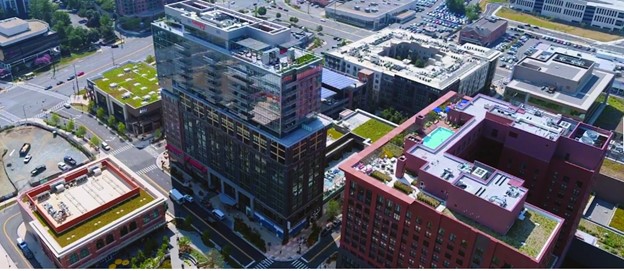Planning, Zoning and Development Review
Best practice: Public Outreach
TOD often faces increased scrutiny from community residents and local politicians, resulting in potential project delays or even derailment. Often, the public perceives that TOD will result in overcrowded schools, lack of parking and increased taxes.
Local officials often encounter political pressure against TOD, leading them to support traditional projects instead.
A 2010 Rutgers University study suggests a lack of knowledge about the benefits and impacts of a TOD may make it difficult to get TOD implemented. Yet, the Rutgers study found that the per-household impacts of new developments near rail stations are much less than in homes farther from rail. To counter negative public perception and political pressure, elected officials who want TOD can increase awareness of its benefits and dispel myths through education and outreach.
White Flint – community outreach leads to increased public support for TOD
 Pike & Rose, a new downtown center near White Flint/North Bethesda Metro Station
Pike & Rose, a new downtown center near White Flint/North Bethesda Metro Station Improved sidewalks accompany redevelopment along Rockville Pike
Improved sidewalks accompany redevelopment along Rockville Pike It was not accidental that Montgomery County successfully adopted the White Flint Sector Plan in 2010, which included significantly higher densities and a range of uses near the White Flint Metro Station.
Initial public reaction was negative. In 2009, of 50 speakers who testified at a Montgomery County Planning Board public hearing, equal numbers testified for and against the plan. Ninety percent were local residents.
A year later, that sentiment had taken a 180-degree turn. At the County Council public hearing, held to adopt – or reject –the draft sector plan, 85 percent of the 91 speakers supported the plan. A full 60 percent of resident testimony was positive, and 400 of 491 letters were in support of the sector plan. The positive feedback resulted in a unanimous approval of the sector plan in 2010 by the Montgomery County Council.
Since the plan adoption, White Flint has seen a surge in projects, including the redevelopment of large strip malls and the design phases of major transportation projects.
The success has a lot to do with the collaborative community outreach efforts led by the White Flint Partnership working closely with Montgomery County staff and planners, various stakeholder committees, and community activists, the most active of which is the group Friends of White Flint.
The White Flint Partnership, an alliance of property owners along MD-355 (Rockville Pike), used creative educational outreach to promote TOD. The partnership, an unusual collaboration among major property owners, united around a goal to improve the corridor by increasing transportation options, improving the streetscape and, thus, walkability and and providing a much more attractive environment to live and work than the congested, unwelcoming Rockville Pike. The partnership conducted public meetings including happy hour events geared at Millennials, offered testimony in support of TOD, hosted a website and took great advantage of social media such as Twitter to push events. Partnership members even went door to door to promote redevelopment efforts, all in a concerted effort to dispel fears by providing as much information to stakeholders as possible. Friends of White Flint, a nonprofit organization of residents, business owners, property owners, and community organizations, also was instrumental in supporting the development and implementation of the White Flint Sector Plan. It used its website, blog and listserv to build support for the building of a sustainable and walkable TOD community in White Flint.
At the same time, county planners staffed a White Flint Advisory Committee and White Flint Steering Committee to conduct public workshops, informational meetings, group presentations to civic and homeowners associations, public agencies and business groups.
After the adoption of the sector plan, in continuing coordination with the White Flint Partnership and community activists, county officials established the White Flint Sector Plan Implementation Advisory Committee and the White Flint Downtown Advisory Committee to implement the plan. Both committees, comprised of property owners, representatives from public agencies and area residents advise and make recommendations to the county executive and county council regarding policies, strategies, issues associated with the plan implementation and development projects.
TOD Best Practices: Planning, Zoning and Development Review
